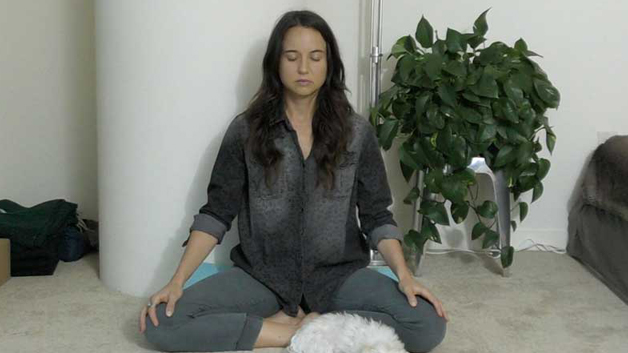Articles, In the Press, Uncategorized, Yin, Restorative and Meditation
Meditation for Healthy Weight Loss

As Mother Nature hits refresh, we can too by taking some time each day to power off our devices and zoom in on our center. Join Yoga Medicine founder Tiffany Cruikshank here each Tuesday to unplug and unwind with new a practice for your #digitaldetox.
“The way we typically think about losing weight has always been: weight loss = torture”. We somehow believe that losing weight is something that must be “endured”. To be effective, it must be painful and unpleasant. Researchers believe this propensity for self-torture may be related to the stigma around extra weight. Overweight people are believed to be “wrong” in our culture, so they must be forced to do their penance.
Yet public health research has proven that shaming people into losing weight never works. Stigma is de-motivating and actually leads to greater relapse rates, depression, and severely compromised overall health. And it’s not your imagination—that stigma has grown dramatically recently. One Yale study estimates that the stigma against people who are overweight increased by 66 percent between 1996 and 2006. Research has documented the stereotypes behind it, which include some extremely harsh words. Lazy, weak-willed, unsuccessful, unintelligent, lack self-discipline, et cetera.
These words are hurtful and usually false. But that doesn’t stop the person who might be carrying extra pounds from hanging on to those labels and internalizing them. And if you’re not aware, that judgment can play like a soundtrack in your head, all day, every day.
But meditation is the perfect antidote. The more we become aware of what’s going on inside our heads, without judging it, the more we can start to notice those unhelpful automatic thoughts and emotional reactions, and the faster we can stop the cycle before it starts.
Use this short meditation to help you become more conscious of these patterns. Begin to rewire the soundtrack in your mind and guide yourself to a healthier mind and body. Repeat daily for best results!
A Meditation for Healthy Weight Loss
Begin by finding a comfortable seat and noticing your breath. Firstly, notice the experience of sitting and all of the sensations—positive and negative—that exist here. Notice how this experience of sitting also encompasses your existence in your body. This may include thoughts and sensations like feeling out of shape, tired, too big for your clothes, heavy in the hips, or aware of the size or shape of other features of your body.
Secondly, notice the judgements around those sensations. Things like: “I need to do a longer yoga practice today to get in shape” or “I wish I didn’t have….(insert your favorite body-loathing feature)” The tricky part here is to notice the judgements without becoming entangled in the emotions associated with them. Lastly, take some time to consider how you might move through your day differently, in this body you have now if you could let go of all the judgements.
How would you feed yourself differently, how would you move differently, how would you interact differently? Spend some time there noticing all the changes in your day, in your life without the judgements including the changes in your health and in the deeper facets of your life. This could take anywhere from 3 to 30 minutes or as long as you like, but spend a little more time the first time around and then try to reconnect to this even briefly every day this week.
Notice the changes right away and imagine the changes that could come with regular practice.
Excerpted from MEDITATE YOUR WEIGHT: A 21-DAY RETREAT TO OPTIMIZE YOUR METABOLISM AND FEEL GREAT. Copyright © 2016 by Tiffany Cruikshank. Published by Harmony Books, an imprint of the Crown Publishing Group, a division of Penguin Random House LLC, on April 5.
See also Tiffany Cruikshank’s 4-Step Bedtime Restorative Practice for Better Sleep. For more information or meditations on metabolism, healthy body image and living a life you love, check out Tiffany’s new book, Meditate Your Weight, available for pre-order now and in a store near you on April 5th.
Originally posted on Yoga Journal.












